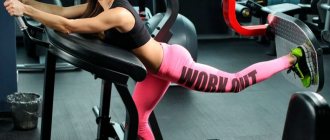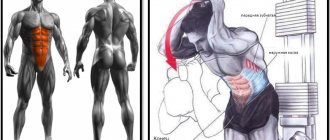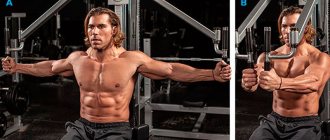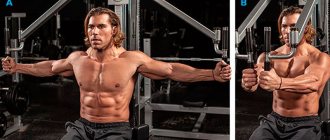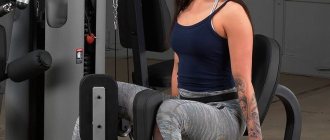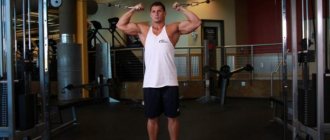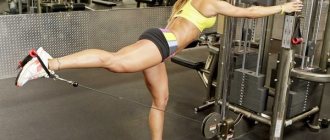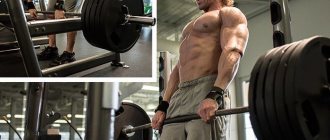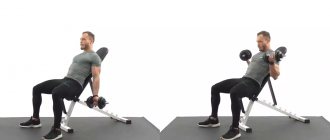Bringing your arms together in a crossover onto the pectoral muscles allows you to qualitatively work out your already fairly developed chest. The exercise is isolating and aims to rather give an aesthetic appearance to the muscles and fill it with blood as much as possible for large volumes.
Professional athletes usually perform classes on this machine at the end of a workout and do not use excessively large weights.
The task they usually set is to refine the area in all areas.
Advantages
Since performing the crossover exercise is an isolating exercise, the athlete improves brain control over the chest area. This means that regular execution will allow you to better strain the trained area in other exercises.
In addition, light weights allow you to do a large number of repetitions. This, in turn, allows you to work out bundles that are less loaded in other trips.
By performing the exercise, bodybuilders work out the central area of the chest, and give the muscles the correct shape and relief.
Execution technique
The standing crossover curl can be modified to place tension on the area being trained.
But in order to get the maximum benefit from the exercise, it is advisable to start mastering the basic technique.
The classic execution is focused on uniform tension and stretching of the large pectoral muscle.
Correct execution technique:
- You need to take a handle in each hand and stand so that your arms spread to the sides are spread as far back as possible and are under tension.
- As you exhale, without bending, they move towards each other and end the movement when one hand is above the other.
- After this, as you exhale, you need to slowly raise your arms to the starting position.
When performing this, you need to ensure that:
The arms had a small and constant angle at the elbow. They should not bend or unbend. The biceps and triceps, as well as the forearm area, perform a stabilizing function, experiencing static tension.
The legs should be in a position that is comfortable for the practitioner. Many people prefer to put one leg slightly forward. This allows you to maintain stability during execution. But you can also place them parallel to each other.
The position of the body relative to the lines of movement determines the loaded area. If the movements are perpendicular to the position of the torso, then the entire group is equally involved in the work.
The lower crossover curl is aimed at working the upper part and is mainly used by professional bodybuilders to give an aesthetic shape to the muscles.
The trainee must create static tension in the abs and buttocks to give stability to the entire body.
The less unnecessary movements associated with rocking and bending of extraneous joints, the greater the load placed on the chest.
Bringing your arms together in an upper crossover is a convenient way to make the lower part of your pecs more prominent.
You can additionally use a bench to transfer the load to the upper area. To do this, you can use a regular bench press. By adjusting the tilt of the plane, you can use any muscle group.
Reduction of hands in a crossover with upper placement of handles
Starting position : secure the handles so that you can grab the handles by stretching your arms up and to the sides, standing straight, and maintaining a forward tilt of the body about 30 degrees from the axis of the spine.
Movement:
- Bring your shoulder blades toward your spine and rotate your shoulders;
- With a conscious effort, contract the pectoralis major muscles;
- At the same time, press your palms onto the handles;
- Bring your hands together in front of you;
- The handles move along an elliptical path;
- Stop – below in the groin area;
- Here, statically tighten your pecs;
- Come back smoothly
Working muscles : pectoralis major as the primary motor, pectoralis minor are involved in the breathing process, serratus – adduct the shoulder blades
In the bodybuilding community, the movement is considered to be targeted at working out the “bottom” of the chest.
Contraindications for performing the exercise
The crossover technique requires that the entire load be directed to the chest area, but the shoulder is movable.
These are some of the most traumatic joints in the human body, and therefore safety precautions must be observed.
The exercises should be performed if there are certain achievements in the normal bench press. A basic exercise, unlike an isolating exercise, allows you to develop secondary areas that have a fixation effect.
In addition, the bench press strengthens the entire shoulder girdle, which helps avoid most joint injuries.
It is advisable to use the exercise at the end of a workout. This is due to the fact that by this moment all the tissues have sufficiently stretched and warmed up.
You need to work with light weights. The most optimal number of repetitions is considered to be 15-20 times per approach.
Unlike the bench press, the crossover should not be aimed at maximum tension. Its task is to fill the area with blood, stretch and improve innervation. Therefore, multi-repetition approaches are encouraged in this case.
If you experience discomfort in the shoulder joints, you should stop exercising.
The entire weight rests on one single joint, which, under constant pressure, will place increased stress on the joint capsule, which in conditions of injury can lead to sad events.
Description[edit | edit code]
Bringing hands together on a crossover
Bring the handles of the block together in front of you, without bending your arms and maintaining a fixed position of your elbow joints. Return to the starting position and repeat the exercise. Moving forward, bring your shoulders together, and returning to the starting position, straighten them.
The main muscles involved when bringing the arms together on a crossover
- Shoulder blade: serratus anterior, pectoralis minor, rhomboids, lower trapezius.
- Shoulder joint: rotator cuff, biceps.
- Elbow joint: triceps, brachialis.
- Wrist joint: wrist flexor muscles.
- Torso: abdominal muscles, gluteal muscles, latissimus dorsi.
- Leg: main muscle groups of the legs.
Techniqueedit | edit code
Initial position
- When bringing your hands together on the crossover, stand in the middle between the two upper blocks and grab the handles.
- Place one foot forward for stability.
- Bend your knees slightly and lean forward slightly
Recommendations for implementation
- Do not use inertial force.
- Do not fully extend your arms at the elbow joints.
- Straighten your chest and shoulders.
- The movement should be performed using the chest muscles.
- Bringing your hands together, exhale.
https://youtube.com/watch?v=SdKhAcE64zE%3F
Reduction of hands (technique)
advertising is not displayed
Movement analysisedit | edit code
| Major joints | Brachial | Acromioclavicular |
| Movements performed in the joints | Down: adduction, partial horizontal adduction, internal rotation. Upward: abduction, partial horizontal abduction, external rotation. | Down: extension, partial external rotation. Up: flattening, partial inward rotation. |
| Main muscles involved in movements | Pectoralis major muscle (mainly sternocostal and abdominal bands), pectoralis minor muscle, anterior deltoid muscle, coracobrachialis muscle, biceps (short head), latissimus dorsi muscle | Serratus anterior muscle |
Women performing the exercise
Bringing your arms together in a crossover for girls is an excellent way to tighten your entire figure. When performed, the muscles become toned, which improves posture and well-being.
In addition, high-repetition exercises are ideal for burning excess calories and regular exercise aimed at maintaining cardiovascular health.
The fair sex can increase the number of approaches to 30. At the same time, you must also follow the execution technique so as not to get injured.
Initial position
Take a bench that suits you and place it in the center of the crossover. Lie on a bench so that the middle of your chest is level with the middle of the blocks. Place your feet shoulder-width apart and rest them on the floor. For a more isolated option, raise your legs up, place your heels on the bench or keep them crossed, the weight in the machine that you will lift will be less, but the isolation on the pectoral muscles will be much greater. Another option is to press your lower back completely into the bench, this will increase the isolation of the pectoral muscles and be sure to elevate your legs on the bench. The back, pelvis and neck are pressed against the bench, the shoulder blades are together, the lower back and legs are in the position of your choice. Grab the handles of the crossover and bring them together; if you feel uncomfortable, ask them to hand them to you. Only D-shaped handles should be used. Take the handles in a lock, with your palms facing each other. Bend your arms slightly at the elbows and keep it that way throughout the entire exercise.
What to replace the exercise with?
There are many people who want to train on this simulator. This issue is especially relevant for small semi-basement gyms, where there is no room for an extra barbell, and even more so for such a massive exercise machine.
How to replace bringing your hands together in a crossover if it is not possible to install the structure in the hall?
Some call the wiring a full replacement. But it's not that simple.
Since the dumbbells are a free weight, the athlete must exert extra effort to keep them balanced. This affects the nerve connection that switches from the pectoral to the shoulder muscles.
Although the movement is similar to a crossover, the muscles are not stretched as well.
The practitioner tries not to drop the projectiles down, which does not allow him to sufficiently relax the fibers.
There are also multifunctional exercise machines, on which the most frequent guest is the so-called butterfly. This is a pair of vertical surfaces, on which the athlete brings his elbows together.
This simulator allows you to focus more on chest isolation. Its disadvantage is insufficient stretching, which, due to the lack of static tension in the arms and shoulders, is greatly reduced.
However, it is possible to replace, although not fully, a crossover. To do this you need to use rubber bands.
By attaching them to the wall at a distance of 2 meters from each other, the athlete can perform scoring approaches at the very end of the workout.
The disadvantage is the difficulty of changing the load. However, this creates constant tension, similar to professional blocks.
How to build a workout
You can add crossovers into your training program after heavier compound exercises. They should be performed in 10-15 repetitions, 2-3 sets with light or medium weight. The technique of movement is of primary importance.
You can also combine crossovers with push-ups, performing a set of both exercises without a break. That is, for example, you do 20-30 push-ups, then 10-15 push-ups at once, then rest - and the next approach.
This is an isolated exercise that perfectly pumps the chest. It differs from dumbbell flyes in that there is constant tension in the chest muscles throughout the entire amplitude of the exercise and allows you to better work out the inner part. Crossover crossovers place less stress on the elbow joints than dumbbell flyes.
Depending on the tilt of the bench, different muscles work:
- lying on a bench upside down puts more stress on the lower pecs;
- lying on a horizontal bench loads the middle of the pectoral muscles;
- Lying on a bench at an angle of 30-40 degrees loads the upper chest.
Why do professionals choose a crossover?
High-repetition exercises allow you to reduce the fat layer between individual groups.
The great Arnold Schwarzenegger performed block sets in every workout. He understood that impressive volumes at that time would not surprise anyone.
He chose the path of increasing aesthetics by drawing each individual group. Thanks to this, people could see every major muscle of his body, its tension and relaxation.
Many believe that thanks to attention to such details, the bodybuilder was able to receive several titles in a row.
